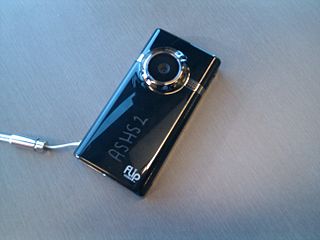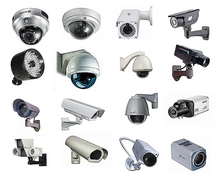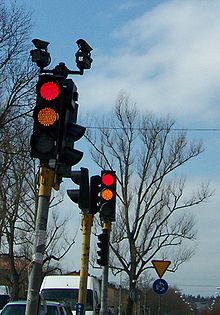
Digital video is an electronic representation of moving visual images (video) in the form of encoded digital data. This is in contrast to analog video, which represents moving visual images in the form of analog signals. Digital video comprises a series of digital images displayed in rapid succession.

Video is an electronic medium for the recording, copying, playback, broadcasting, and display of moving visual media. Video was first developed for mechanical television systems, which were quickly replaced by cathode-ray tube (CRT) systems which, in turn, were replaced by flat panel displays of several types.

D-1 or 4:2:2 Component Digital is an SMPTE digital recording video standard, introduced in 1986 through efforts by SMPTE engineering committees. It started as a Sony and Bosch - BTS product and was the first major professional digital video format. SMPTE standardized the format within ITU-R 601, also known as Rec. 601, which was derived from SMPTE 125M and EBU 3246-E standards.

A camcorder is a self-contained portable electronic device with video and recording as its primary function. It is typically equipped with an articulating screen mounted on the left side, a belt to facilitate holding on the right side, hot-swappable battery facing towards the user, hot-swappable recording media, and an internally contained quiet optical zoom lens.
A digital video recorder (DVR) is an electronic device that records video in a digital format to a disk drive, USB flash drive, SD memory card, SSD or other local or networked mass storage device. The term includes set-top boxes with direct to disk recording, portable media players and TV gateways with recording capability, and digital camcorders. Personal computers are often connected to video capture devices and used as DVRs; in such cases the application software used to record video is an integral part of the DVR. Many DVRs are classified as consumer electronic devices; such devices may alternatively be referred to as personal video recorders (PVRs), particularly in Canada. Similar small devices with built-in displays and SSD support may be used for professional film or video production, as these recorders often do not have the limitations that built-in recorders in cameras have, offering wider codec support, the removal of recording time limitations and higher bitrates.
Betacam is a family of half-inch professional videocassette products developed by Sony in 1982. In colloquial use, "Betacam" singly is often used to refer to a Betacam camcorder, a Betacam tape, a Betacam video recorder or the format itself.

A video camera is an optical instrument that captures videos. Video cameras were initially developed for the television industry but have since become widely used for a variety of other purposes.
Transcoding is the direct digital-to-digital conversion of one encoding to another, such as for video data files, audio files, or character encoding. This is usually done in cases where a target device does not support the format or has limited storage capacity that mandates a reduced file size, or to convert incompatible or obsolete data to a better-supported or modern format.
HD-MAC was a broadcast television standard proposed by the European Commission in 1986, as part of Eureka 95 project. It belongs to the MAC - Multiplexed Analogue Components standard family. It is an early attempt by the EEC to provide High-definition television (HDTV) in Europe. It is a complex mix of analogue signal, multiplexed with digital sound, and assistance data for decoding (DATV). The video signal was encoded with a modified D2-MAC encoder.

HDV is a format for recording of high-definition video on DV cassette tape. The format was originally developed by JVC and supported by Sony, Canon, and Sharp. The four companies formed the HDV Consortium in September 2003.
Image resolution is the detail an image holds. The term applies to digital images, film images, and other types of images. "Higher resolution" means more image detail.
A DVD recorder is an optical disc recorder that uses optical disc recording technologies to digitally record analog or digital signals onto blank writable DVD media. Such devices are available as either installable drives for computers or as standalone components for use in television studios or home theater systems.

P2 is a professional digital recording solid-state memory storage media format introduced by Panasonic in 2004, and especially tailored to electronic news-gathering (ENG) applications. It features tapeless (non-linear) recording of DV, DVCPRO, DVCPRO25, DVCPRO50, DVCPRO-HD, or AVC-Intra streams on a solid-state flash memory. The P2 card is essentially a RAID of Secure Digital (SD) memory cards with an LSI controller tightly packaged in a die-cast PC Card enclosure, so data transfer rate increases as memory capacity increases. The system includes cameras, decks as drop-in replacements for videocassette recorders (VCR), and a special 5.25-inch computer drive for random-access integration with non-linear editing systems (NLE). The cards can also be used directly where a PC card (PCMCIA) slot is available, as in most older notebook computers, as a normal hard disk drive, although a custom software driver must first be loaded.
High-definition video is video of higher resolution and quality than standard-definition. While there is no standardized meaning for high-definition, generally any video image with considerably more than 480 vertical scan lines or 576 vertical lines (Europe) is considered high-definition. 480 scan lines is generally the minimum even though the majority of systems greatly exceed that. Images of standard resolution captured at rates faster than normal, by a high-speed camera may be considered high-definition in some contexts. Some television series shot on high-definition video are made to look as if they have been shot on film, a technique which is often known as filmizing.

Digital cinematography is the process of capturing (recording) a motion picture using digital image sensors rather than through film stock. As digital technology has improved in recent years, this practice has become dominant. Since the mid-2010s, most movies across the world are captured as well as distributed digitally.

Digital photography uses cameras containing arrays of electronic photodetectors interfaced to an analog-to-digital converter (ADC) to produce images focused by a lens, as opposed to an exposure on photographic film. The digitized image is stored as a computer file ready for further digital processing, viewing, electronic publishing, or digital printing.
Uncompressed video is digital video that either has never been compressed or was generated by decompressing previously compressed digital video. It is commonly used by video cameras, video monitors, video recording devices, and in video processors that perform functions such as image resizing, image rotation, deinterlacing, and text and graphics overlay. It is conveyed over various types of baseband digital video interfaces, such as HDMI, DVI, DisplayPort and SDI. Standards also exist for the carriage of uncompressed video over computer networks.

A network video recorder (NVR) is a specialized computer system that includes a software program that records video in a digital format to a disk drive, USB flash drive, SD memory card or other mass storage device. An NVR contains no dedicated video capture hardware. However, the software is typically run on a dedicated device, usually with an embedded operating system. Alternatively, to help support increased functionality and serviceability, standard operating systems are used with standard processors and video management software. An NVR is typically deployed in an IP video surveillance system.
This glossary defines terms that are used in the document "Defining Video Quality Requirements: A Guide for Public Safety", developed by the Video Quality in Public Safety (VQIPS) Working Group. It contains terminology and explanations of concepts relevant to the video industry. The purpose of the glossary is to inform the reader of commonly used vocabulary terms in the video domain. This glossary was compiled from various industry sources.
A video management system, also known as video management software plus a video management server, is a component of a security camera system that in general:
















